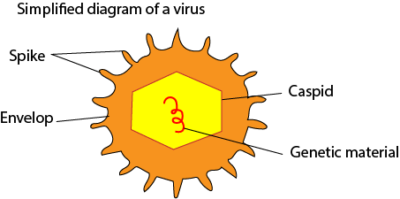
Viruses (A-biology)

Viruses
Specific objectives
- Describe the general structure of a virus
- Explain characteristic of viruses
- Describe economic importance of viruses
- Outline methods of preventing the spread of viruses.
Viruses cannot be classified into any Kingdom because, they are on the borderline between living and non-living things. Viruses are smaller than bacteria and cannot be seen with a light microscope. Viruses are living thing because they contain nucleic acid in form of DNA or RNA.
Viruses are made of two components, that is nucleic acid and protein coat. Most viruses are found in animal cells and those that attach bacteria are called bacteriophage. Viruses have a variety of shapes; i.e. spherical such as poliomyelitis, straight rods such as tobacco mosaic (TMV), or flexible rods such as potato viruses.

Transmission of viruses
Viruses cannot reproduce outside animal cell and for this reason are referred to as obligate parasite. Viruses infect body cell, incorporate their DNA into the host DNA and manipulate the cell to synthesize the amino acids for viruses. Sometimes incorporation of Virus DNA into host DNA or transduction results into new characteristics in the hosts such as antibiotic resistance in bacteria.
Transduction in bacteria refers to the process by which DNA is transferred from one bacterium to another by a microphage (bacteriophage or virus, e.g. HIV). The genetic material microphage (a vector) is incorporated into the DNA of the bacterium so that the bacterium now functions as a machine that manufactures the phage amino acids
Related to transduction is Transformation; a process by which bacterial DNA is changed as a result to direct uptake and incorporation of foreign DNA its surrounding through the cell membrane.
Economic importance
- Viruses cause diseases to plants such as tobacco bright and tomato mosaic by (TMV)
- Viruses cause diseases to animals as rabies, flu, polio, HIV and cancers.
- May lead to antibiotic resistance by bacteria.
- Used in genetic engineering.
Control of the spread of viral disease
- Burning infected plants
- Abstinence or use of a condom to prevent HIV
- Quarantine for highly infectious viruses such as small pox, COVID-19.
- Vaccination
NB. Viral diseases are difficult to treat because viruses are continuously mutating.
Viral diseases to plants
- curly top
- mosaic
- psorosis
- spotted wilt
Examples of viral diseases in animals
sinusitis,
the common cold.
Influenza
Pneumonia
HIV
smallpox
COVID-19
Exercise
Viruses resemble living organisms because they possess
A. a nucleus
B. Genetic material.
C. a cell membrane.
D. oxidative enzymes.
Answer: B

Thanks for providing such valuable insights. Bags Wallet & Luggage
I really enjoyed reading this. Well done! TamilBlasters Com
Secure a seat in top medical colleges with MBBS Admission Through Management/Nri Quota in Delhi, offering streamlined admissions.
Get details on eligibility criteria at MBBS Cutoff Of Private Medical Colleges in Chhattisgarh.
Join millions of players using the Raja Luck App for entertainment and rewards.
Explore data-driven insights on Raja Luck.
Delight in quick and safe access to your gaming account with 82 Lottery Login.
Dive into the world of Goa Games and test your strategy skills in a vibrant, immersive environment.
Participate in TS EARN’s referral program by sharing your Invite Code and enjoy cumulative benefits.
Increase your jackpots with special advantages from the Diu Win Invite Code.
Host your applications and handle data easily with Server Rental in Delhi.
Optimize your company’s tech strategy with Technology Roadmap Planning for future development.
The flavors in the Pahadi dishes from Joshital took me back to my roots– definitely scrumptious!
Stay upgraded on current affairs with **Bangla News**, featuring the most recent headings and trends.